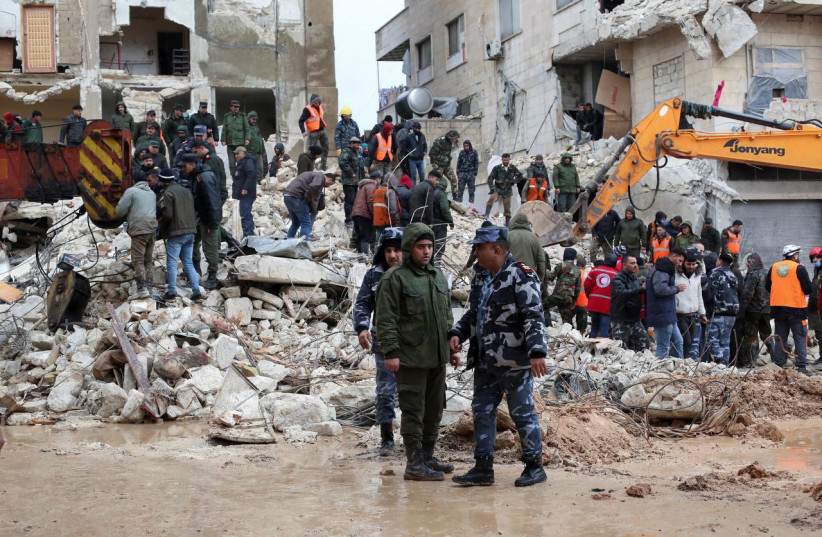Unlike in Turkey, where numerous international search-and-rescue delegations arrived and began searching for survivors within 24 hours of the earthquake, Syria’s victims have, for the most part, remained under the rubble.
While some aid has flowed to Damascus, there are Western countries that see the Syrian regime as a pariah and don’t want to send aid if the regime will merely snatch it for itself. At the same time, a bizarre UN system, set up with Russian and Chinese backing, has meant that aid could only flow into opposition-controlled parts of northwestern Syria via one damaged border crossing.
It is now too late to save the Syrian victims, and the suffering continues. People need medical care, and reconstruction is imperative. Syria has already been badly scarred by a decade of war, which only adds to the misery.
Currently, millions of Syrian refugees are in Turkey, Jordan, Iraq and Europe. According to a UN estimate, approximately five million more could be homeless in Syria after the earthquake. France has offered $12.8 million via UN agencies, according to reports.
The challenges don’t end there. Turkey currently occupies northwest Syria, including Afrin, Idlib and Jarabulus. As the occupying power, Turkey is supposed to be responsible for the native population – the victims. But its resources are already strained by its own tens of thousands of casualties and thousands of collapsed buildings.
There are also extremist groups in northwest Syria – some backed by Turkey and some operating independently. According to one report, a “hardline group” has already held up aid from reaching victims. There are active aid groups there that operated during the Syrian civil war, including the White Helmets and the Syrian American Medical Society.
What is clear is that the current framework for how Syria operates is not tenable. Some players in the international community, primarily the US, want the Syrian regime isolated, which has led to sanctions.
But what happens when aid runs into sanctions?
But what happens when aid runs into sanctions? The US has now exempted aid relief from sanctions, but this took days and shows how the issue of helping average people is challenged by the division inside Syria. Areas in Idlib and Afrin are only accessible via Turkey, itself harmed by the earthquake, making it even harder for aid to get through.
The lone crossing at Bab al-Hawa in Reyhanli was also damaged by the quake. Located in the Hatay province, it is in an area that was not only damaged, but has many other problems on the ground, such as chaos, infighting and the government in Ankara.
So what can be done?
Some innovative attempts to aid Syria have come up against these challenges. The Barzani Charity Foundation from the Kurdistan Region of northern Iraq, based in Erbil, sent aid to Afrin in Syria via Turkey.
“With 12 trucks carrying 50 tons of food, medicine, and essential items, the BCF convoy crossed into rebel-held Afrin through the Bab al-Salameh border crossing from Turkey to deliver aid to Afrin city and nearby Jindires township where people were left homeless in a freezing winter, and hopes of rescuing their loved ones from underneath countless buildings that were turned to rubble faded,” Rudaw media in Erbil reported. “On Saturday, the death toll stood at more than 25,200 people from the earthquakes in both Turkey and Syria.”
Aid also was dispatched to the US-backed Syrian Democratic Forces (SDF) area from regime-controlled areas in eastern Syria via some sort of arrangement. This could include Aleppo, Tal Rifat and Afrin, but it was not clear if the regime would allow this aid to pass.
There is a push in the international community to open more border crossings and provide aid to Syria that can pass though regime- and opposition-held areas, without all the bureaucracy, the extremists and UN issues that have turned aid into a political weapon.
“Providing extra border crossings from Turkey into Syria is an ‘open and shut case’ on humanitarian grounds following the catastrophic mega-disaster, a UN aid chief told Sky News… Stressing the urgency of the situation, Martin Griffiths said additional corridors were needed now to bolster the amount of assistance reaching the stricken earthquake-hit region and save lives,” Sky News reported.
This makes sense, but it also illustrates how aid was mismanaged in the past. Because the UN and state actors prefer to work with states rather than non-state actors, this meant that throughout the Syrian conflict, many countries preferred to work only with the Syrian government and international organizations.
Because Russia backs the Syrian regime, it was able to make sure this system continued. Even though the US entered eastern Syria to back the SDF against ISIS, and Turkey invaded northern Syria, the UN, Russia and others made sure that only one or two border crossings would exist for aid to enter places such as Idlib or Rojava in eastern Syria.
This was a cynical attempt to cut Syria off from all sides. For backers of the regime, however, it made perfect sense because the “government” had to be the only conduit for official aid. As the regime has made progress defeating the rebels, and as it now meets with Turkey, it appears that the system worked in Damascus for a while.
In the Middle East, many countries want to normalize ties with Syria, and the earthquake may give a green light for countries to aid Damascus and lead to diplomatic changes on the ground.
It is not clear how Turkey will manage these changes or whether they may lead to a ceasefire. Temporary border openings and aid to Damascus are just a few of the issues on the table.

